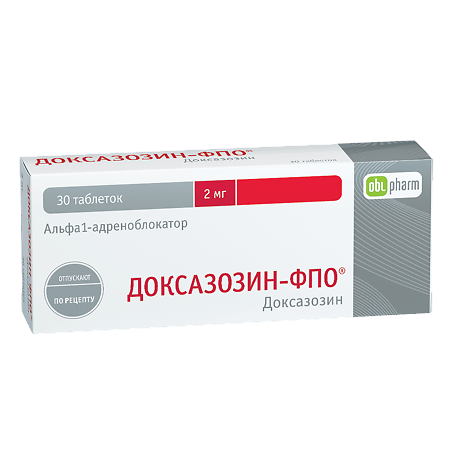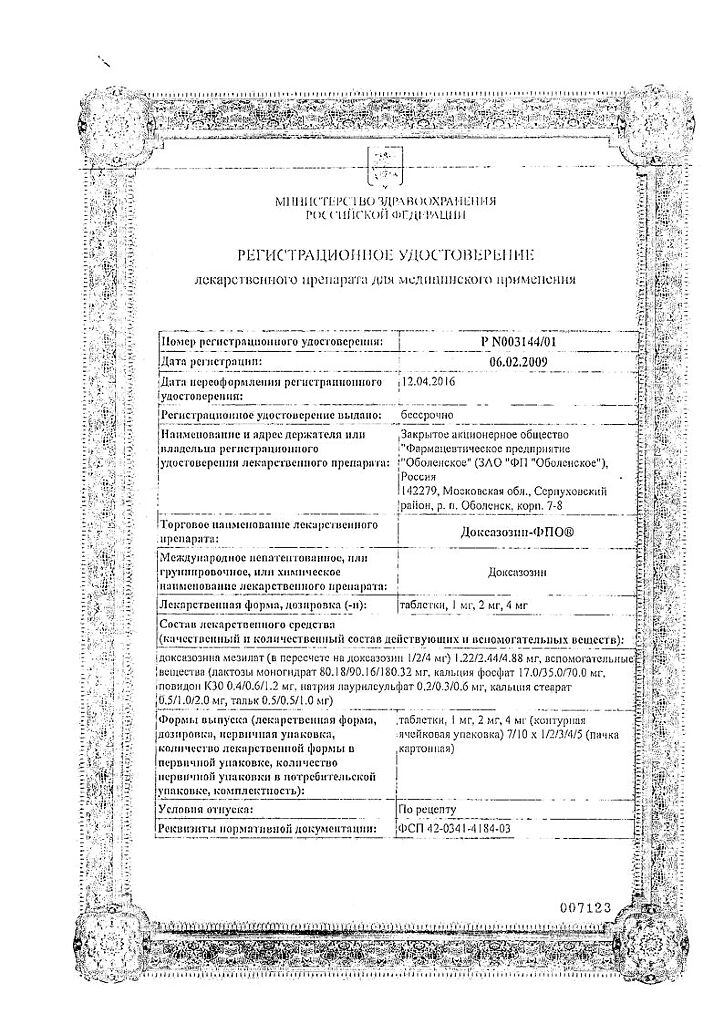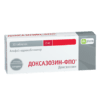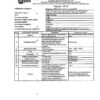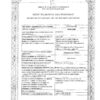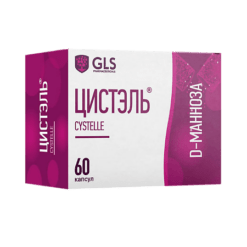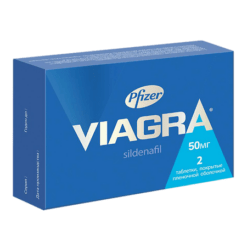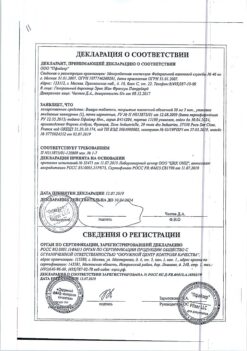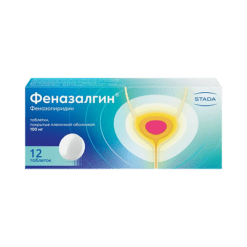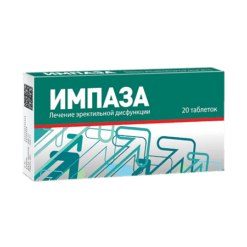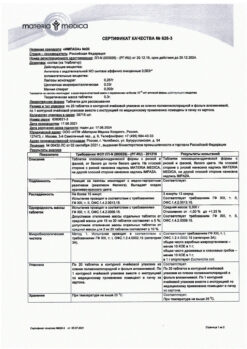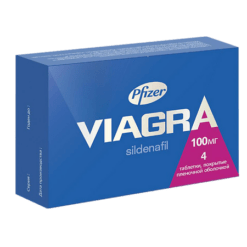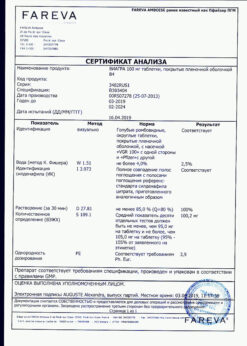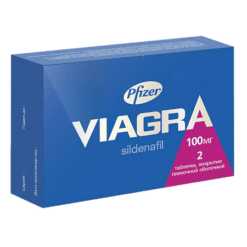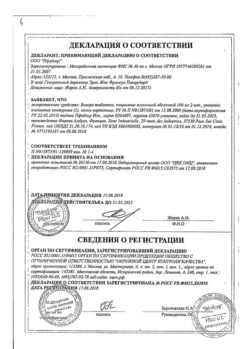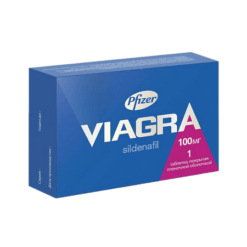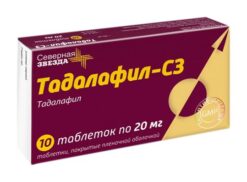No products in the cart.
Doxazosin-FPO, tablets 2 mg 30 pcs
€5.63 €5.00
Description
Doxazosin is hypolypidemic, hypotensive, antispasmodic, vasodilator.
It selectively blocks postsynaptic alpha1-adrenoreceptors. By reducing the tone of the vascular muscles, it reduces the RAS and lowers BP. It decreases concentrations of triglycerides, total cholesterol and HDL in plasma. At the same time there is a slight increase in HDL to total cholesterol ratio (by 4-13%).
Inhibits platelet aggregation and increases the content of active plasminogen in tissues. Reduces the tone of the smooth muscle cells of the stroma and capsule of the prostate as well as the bladder neck. Lowers resistance and pressure in the urethra, reduces the resistance of the internal sphincter.
Pharmacodynamics
The hypotensive effect is achieved in 2-6 hours after single administration and persists for 24 hours. During treatment, there is no difference in BP values in standing and lying position in patients with arterial hypertension. With long-term treatment regression of left ventricular hypertrophy is observed.
Pharmacokinetics
It is well absorbed after oral administration. Absorption is 80-90% (simultaneous intake slows down absorption by 1 hour), Cmax is reached after 3 hours, when taken in the evening after 5 hours.
Bioavailability – 60-70% (presystemic metabolism). Binding to plasma proteins is about 98%. It is quickly metabolized in liver by o-demethylation and hydroxylation. Excretion from plasma occurs in two phases, T1/2 – 19-22 hours. It is excreted through the intestine mainly as metabolites, 5% is excreted unchanged in the urine.
Indications
Indications
Arterial hypertension (monotherapy and in combination with other antihypertensive drugs: thiazide diuretics, beta-blockers, calcium channel blockers or ACE inhibitors), benign prostatic hyperplasia (in the presence of arterial hypertension and normal blood pressure).
Pharmacological effect
Pharmacological effect
Doxazosin – hypolipidemic, hypotensive, antispasmodic, vasodilator.
Selectively blocks postsynaptic alpha1-adrenergic receptors. By reducing vascular muscle tone, it reduces peripheral vascular resistance and lowers blood pressure. Reduces the concentrations of triglycerides, total cholesterol and HDL in plasma. At the same time, there is a slight increase in the HDL ratio in relation to total cholesterol (by 4–13%).
Suppresses platelet aggregation and increases the content of active plasminogen in tissues. Reduces the tone of smooth muscle cells of the stroma and capsule of the prostate gland, as well as the neck of the bladder. Reduces resistance and pressure in the urethra, reduces the resistance of the internal sphincter.
Pharmacodynamics
After a single dose, the hypotensive effect is achieved within 2–6 hours and persists for 24 hours. During the treatment period in patients with arterial hypertension, there are no differences in blood pressure values in the standing and lying position. With long-term treatment, regression of left ventricular hypertrophy is observed.
Pharmacokinetics
Well absorbed after oral administration. Absorption – 80–90% (simultaneous food intake slows down absorption by 1 hour), Cmax is achieved after 3 hours, when taken in the evening after 5 hours.
Bioavailability – 60–70% (presystemic metabolism). Plasma protein binding is about 98%. Rapidly metabolized in the liver by o-demethylation and hydroxylation. Excretion from plasma occurs in 2 phases, T1/2 – 19–22 hours. It is excreted through the intestines mainly in the form of metabolites, 5% is excreted in the urine unchanged.
Active ingredient
Active ingredient
Doxazosin
Composition
Composition
Active ingredient:
doxazosin mesylate;
Excipients:
milk sugar,
sodium glycolate,
starch,
magnesium stearate,
MCC,
sodium lauryl sulfate
Contraindications
Contraindications
Hypersensitivity, pregnancy, breastfeeding, age under 18 years.
Side Effects
Side Effects
When using doxazosin, especially at the beginning of treatment, orthostatic hypotension is most often observed, which in rare cases can lead to fainting. In order to prevent orthostatic hypotension, patients should avoid sudden and sudden changes in body position (moving from a lying position to a standing position).
May experience: headache, dizziness, general feeling of weakness, increased fatigue, drowsiness, rhinitis, nausea. Patients with arterial hypertension rarely experience: tachycardia, arrhythmia, chest pain, angina attacks, myocardial infarction, cerebrovascular disorders.
There were isolated cases of allergic reactions (skin rash, jaundice, thrombocytopenic purpura, increased transaminase levels), dry mouth, nosebleeds, priapism, urinary incontinence, increased appetite, constipation, increased diuresis, myalgia, arthralgia.
Interaction
Interaction
Strengthens the hypotensive effect of antihypertensive drugs.
Compatible with thiazide diuretics, furosemide, beta-blockers, calcium channel blockers, ACE inhibitors, antibiotics, oral hypoglycemic agents, indirect anticoagulants and uricosuric agents.
When combined with inducers of microsomal oxidation in the liver, an increase in effect is possible, and with inhibitors – a decrease. NSAIDs (especially indomethacin), estrogens and sympathomimetic drugs reduce the hypotensive effect.
Reduces the pressor effect of ephedrine. Eliminating the alpha-adrenergic stimulating effects of epinephrine can lead to a distortion of its pressor effect and the development of tachycardia.
Overdose
Overdose
Symptoms: pronounced decrease in blood pressure, sometimes accompanied by fainting.
Treatment: it is necessary to transfer the patient to a horizontal position (lower his head down, raise his legs), symptomatic therapy.
Storage conditions
Storage conditions
In a place protected from light, at a temperature of 5–25 °C.
Shelf life
Shelf life
2 years
Manufacturer
Manufacturer
Obolenskoye FP JSC, Russia
Additional information
| Shelf life | 2 years |
|---|---|
| Conditions of storage | In a light-protected place at 5-25 °C. |
| Manufacturer | Obolenskoe FP JSC, Russia |
| Medication form | pills |
| Brand | Obolenskoe FP JSC |
Related products
Buy Doxazosin-FPO, tablets 2 mg 30 pcs with delivery to USA, UK, Europe and over 120 other countries.

